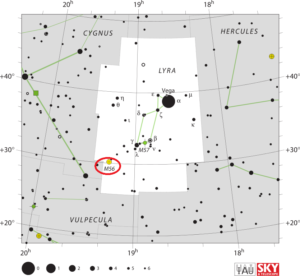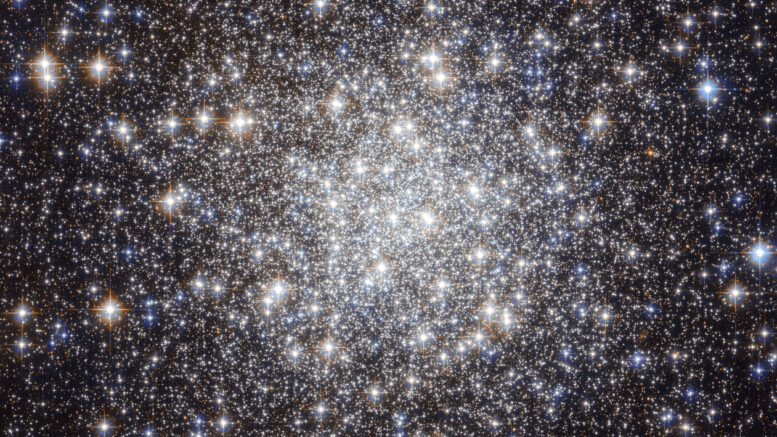Messier 56 is a globular cluster in the constellation Lyra. It was discovered by Charles Messier on January 19, 1779. The cluster is located almost midway along an imaginary line between Albireo and Sulafat. Astronomers have found that most of clusters with the same type of chemical makeup as Messier 56 lie along a plane in the Milky Way’s halo. This suggests that such clusters were captured from a satellite galaxy, rather than being the oldest members of the Milky Way’s globular cluster system as astronomers had previously thought.
| Description | |
| Visible From Pacific Northwest | March To October |
| Best Time To Observe | June and July |
| Minimum Size Of Viewing Device | Medium Sized Telescope |
| Object Type | Globular Star Cluster |
| Designations | Messer 56, M56, NGC 6779, GCl 110, C 1914+300, GCRV 11736, MWSC 3077 |
| Right Ascension | 19h 16m 35.57s |
| Declination | +30°11’00.5” |
| Constellation | Lyra |
| Number Of Stars | 80,000 |
| Apparent magnitude | +8.3 |
| Apparent dimensions | 8′.8 |
| Object Radius | 42 light years |
| Distance From Earth | 32,900 light years |
History
The cluster was discovered by Charles Messier on January 19, 1779.
William Herschel was the first to resolve M56 into stars around 1784. He described it as a “globular cluster of very compressed small stars about 4 or 5 minutes in diameter.”
John Herschel catalogued the object as h 2036 in 1825 and later added it to his General Catalogue as GC 4485, describing it as a “globular cluster; bright; large; irregularly round; gradually very much compressed toward the middle; well resolved; stars from 11th to 14th magnitude.”
Locating M56 In The Sky
Messier 56 is relatively easy to find because it lies roughly halfway along the line from Albireo, Beta Cygni, to Sulafat, Gamma Lyrae. Albireo, a famous double star, marks the beak of the celestial Swan and the base of the Northern Cross, while Sulaphat can be located in Lyra, on the opposite side to the bright Vega.

Viewing M56
4-inch telescopes show a round ball of light, but do not reveal much detail. Visually, observers can only see the cluster’s central region, about 3 arc minutes in diameter. The best time of year to observe M56 is during the summer months.
The cluster can be a challenge in binoculars because it is quite dim and does not have a bright core. In large binoculars, it appears as a fuzzy patch or an out-of-focus star. To resolve it into individual stars, one needs an 8-inch or larger telescope.
Photographing M56
Globular clusters are honestly low hanging fruit if you have a quality refractor Short exposures are the best option for globular clusters for imaging as short exposures will not saturate the star cores and it is far easier to preserve the star colors both in the cluster itself and in the surrounding sky. It is worth noting that globular clusters are less affected by moonlight than other Deep Sky objects.
To take images of Messier 56, make sure to utilize the following types of filters: Blue, Red, Green, and Infrared. Accurate autoguiding will be required to make sure that the stars to not lose their crispness or else utilize short exposure times. There aren’t many great guides to help those looking for tips, but forums such as cloudy nights and astrobin provide great ways to look at the work that others have done with the same gear. This can allow one to infer what options are available to them.
https://www.astrobin.com/345359/?nc=user
Sources And Further Reading
Descriptions of all of Messier Objects can be found here.
https://freestarcharts.com/messier-56
https://www.nasa.gov/feature/goddard/2017/messier-56

Be the first to comment on "Messier 56"